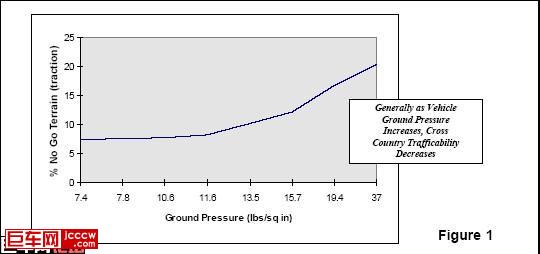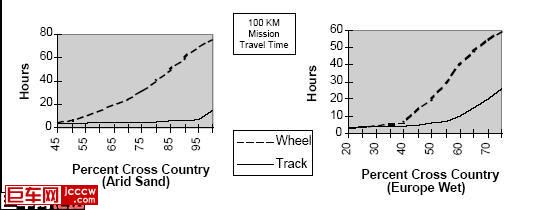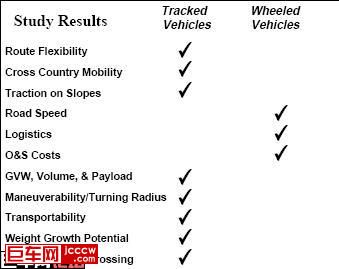转自ww2bbs.net:
==================
“谨以本文献给那些仍在追求真理的道路上苦苦研究的人,关于轮式和履带式车辆的讨论牵扯到了越来越多的东西,这个坑越来越大,要不是碰巧有下面一篇文章的出现我还不敢下笔写这些东西。即使现在写了,个人也还感觉有很多的不足,有很多有待研究的东西。希望各位读者,朋友,专家能指出其中的不足,帮助我一起进步。好了废话说完了,我们先来看看这篇原文。”
With the development of any new Army combat vehicle, the question, “Which is better: a wheeled vehicle or a tracked vehicle?” surfaces again and again. In order to answer this question, the U.S. Army has tested and studied the merits and shortfalls of wheeled and tracked combat platforms for the past 30 years. Results indicate that no single criterion can be applied that will answer the wheeled-versus-track issue for all situations and missions. In fact, the underlying premise in resolving the wheeled-versus-track dilemma is deeply rooted in the complex variables regarding the platform’s combat mission, terrain profile, and specific vehicular characteristics. Tests and studies, however, established a set of criteria to determine a platform’s optimal configuration. Although most of this information is over ten years old, the basic factors which impact the physics of mobility have not changed and are still relevant.
现在研发任何一款新型的军用作战车辆都会一再的面临以下的一个问题“是使用轮式还是履带式的更好?”(这个问题不光是军用机械,就连一些需要在复杂地形上运用的车辆都面临这个问题)。为了回答这个问题,美军对过去30年的轮式和履带式作战平台进行了对比测试,试图从中找出其优缺点来回答这个问题。测试的结果表明,我们不能在不考虑其使用的环境和具体的任务就武断的说在轮式或者履带式一定好。事实上要分析到底使用履带还是轮式车辆更好,首先需要深入的研究这个作战平台的作战任务、使用场合的地形地貌和一些特殊的运载特性要求等复杂的变量。不过本项试验研究至少提供了一套标准去确定使用那一种行走机构更适合我们的作战平台。虽然里面的数据至少是10年以前的,但是影响机动性的基本物理因素没有发生变化,仍然是那几个,所以可以认为试验研究还是有意义的。
MOBILITY:Mobility, as defined by the 1988 Mobility Analysis for the TRADOC Wheeled-Versus-Track Study, is the ability to move freely and rapidly over the terrain of interest to accomplish varied combat objectives.1 Mobility is thus measured by a system’s freedom of movement (percent of the terrain over which the vehicle is mobile) and its average speed or travel time over that terrain. A platform’s gross vehicle weight and its footprint (the area of track or tire which impacts the ground) determine the resultant ground pressure that the platform imparts on the soil. The soil strength, coupled with the vehicle’s characteristic ground pressure, determine a parameter entitled Vehicle Cone Index (VCI), which is a key first-order discriminator of a platform’s mobility. The higher the VCI, or ground pressure, the less mobile the platform becomes. Figure 1 shows that, as ground pressure increases, so does the percentage of No-Go Terrain (terrain over which a combat platform is immobile) due to traction loss in wet, temperate areas.
机动性:机动性的情况来源于1988年训练与条令司令部(全称Training and Doctrine Command)进行的轮式和履带式车辆运动分析比较的研究。其研究的主要能容是测试作战平台面在完成不同的作战目标时可能会遇到的各种地貌上的运动速度和能力。所以首先机动性就有了一个测试标准就是该武器平台的机动性能(该车辆能在百分之多少的地形上行驶)和它在该地形上行驶时的平均速度或者是耗时多少。一个作战平台安装在某一种行走机构上后它们的总重和车辙印(履带或者轮胎在地面样碾压出来的车辙的面积)决定了这个作战平台碾压在泥土上的时候对地面所产生的压力的大小。我们用一个参数来表示土壤的硬度与车辆对地面的压强这两个参数共同作用的情况,这个参数我们称为车辆圆椎指数(缩写VCI),这是第一个决定作战平台机动能力的参数。较高的VCI或者地表压强会降低车辆的机动性能。从表1我们可以看到,当车辆对地压强上升,会使得更多的牵引力被潮湿,高温的泥土所消耗,导致能通过不能地形的百分比上升(作战平台不能在其上机动的地貌)。

A vehicle’s mobility is impacted by its tractive ability over various soil types (dry, wet, sand, or snow-covered) and its ability to maneuver over obstacles, cross gaps, and negotiate varied vegetation. As a general rule of thumb, a lower VCI not only equates to better soft-soil mobility but also indicates better performance on slopes, in sandy terrain, over obstacles/gap crossings and when overriding vegetation. From a mobility perspective, tracked vehicles offer the best solution for a versatile platform that is required to operate over diverse terrain, including extremely difficult ground, because tracks inherently provide a greater surface area than wheels, resulting in a lower VCI. Recent operations in Bosnia have demonstrated the inherent weaknesses of wheeled vehicles with regard to mobility and protection. When operations were conducted on roads, wheeled vehicles demonstrated excellent mobility and speed; but when off-road usage was required, and wet or snow conditions prevailed, mobility suffered.
一辆车辆的牵引力会受到不同类型的土壤(干的、湿的、沙或者积雪上)的影响,这样会导致他的越障碍、壕沟和不同林木的能力发生变化。凭一般的经验而言,低的 VCI不仅等同于在软土地上能有较好的机动能力,也意味着在斜坡、沙地、越障碍、壕沟和穿越林木时都具有较好的机动性能。从机动能力来看,履带车辆最适合那种要求在包括极端恶劣的地形下的任何场合都能使用的万能型作战平台,这是因为履带车辆天生就比轮式车辆对地的接触面积大,这使得履带车辆的VCI较低。最近在波斯尼亚的一个试验证明了轮式车辆在机动能力和保护上天生较弱。而针对公路进行的试验表明,轮式车辆在公路上拥有较高的机动性能和速度;但是当测试越野能力的时候,湿土或积雪环境的时候轮式车辆的不足就彻底暴露出来了。
Wheeled vehicles inherently attain faster road speeds and, therefore, offer the best solution where unrestricted mobility is not the primary mission driver and on-road usage exceeds off-road usage. So, vehicle weight and off-road usage constitute two key criteria for mobility. Figure 2 compares the average 100 km mission travel time for both wheeled and tracked platforms as off-road usage increases (recall that mobility was defined as both freedom of movement and travel time over the terrain).
轮式车辆天生就能达到较快的公路速度,因此,它更适合作战平台所需要的不是较高的越野能性能,换句话说对在公路上的使用机率要高于越野的机率的场合。所以,车辆的重量和越野使用的机率是决定机动性能好坏的另外两个重要参数。表2对比了平均进行100公里行驶时,随着其中越野距离所占百分比的增加,轮式车辆和履带车辆所消耗时间的长短。

As off-road usage dominates the vehicle’s profile, tracked configurations provide significantly better mission travel times. Consequently, Army studies indicate that when a vehicle’s mission requires off-road usage greater than 60 percent and gross vehicle weight exceeds 10 tons, a tracked configuration is preferred for combat roles. However, when the gross vehicle weight exceeds 20 tons and off-road usage remains above 60 percent, a tracked configuration is required to guarantee the best mobility for unrestricted, all-weather tactical operations.
对越野能力的要求基本上可以决定车辆的外形轮廓,当在越野的时候履带式车辆的耗时明显短得多。因此军方研究表明,当车辆执行的任务60%以上是需要越野的,且车辆自重超过10吨的时候,使用履带车辆要比轮式车辆更适宜。而假如当车重超过20吨,越野任务超过60%的时候,你要想获得全路况、全气象下较好的越野能力,履带车辆就成为了当仁不让的选择。
SURVIVABILITY:A combat platform’s survivability is dependent on numerous criteria, to include mine and ballistic protection, size/silhouette, and stealthiness. Tracked vehicles, by design, are inherently more compact than wheeled vehicles. The primary reasons for a tracked vehicle’s compactness are reduced suspension clearance, wheel turning clearance, and the absence of multiple transfer cases and drive shafts that are integral to the design of multiwheeled vehicles. Army studies have indicated that, for a comparable VCI (or ground pressure) at the same gross vehicle weight, wheeled platforms require up to six times more volume for drive train and suspension components than tracked platforms. This results in up to a 28 percent increase in vehicle volume if the same interior volume is maintained. Survivability analyses clearly indicate that a larger size is more readily seen and subsequently hit and destroyed. Additionally, as a combat platform’s size increases, so does the gross vehicle weight (provided the same ballistic and mine protection are maintained), which tends to degrade vehicle mobility and deployability.
存活能力:决定作战平台的存活的因素有很多,例如对于地雷和弹道武器的防御能力,外形尺寸/轮廓和隐蔽性。从设计上来看履带车辆比轮式车辆要更紧凑。首先,履带车辆的因为减小了悬挂机构、转向机构并取消了多轮驱动轮式车辆所必不可少的并联的变速箱和驱动轴,因此其外形要比轮式车辆更紧凑。军队的研究表明相同总重的车辆,要获得相同的VCI(地表压强)轮式战斗平台需要六倍体积于履带式战斗平台的驱动系统和悬挂系统。这就会导致在保持同样的车内容积的情况下,轮式车辆的体积要高出履带车辆28%。对存活能力进行的分析清楚的表明更大的体积意味着更容易被敌人发现,然后就是更容易被击中和击毁。此外作战平台尺寸的增加也会导致车辆总重的增加(在对地雷和弹道武器防御能力保持不变的前提下),这样一来又会影响作战平台的机动性能和可部署的能力。
In general, wheeled platforms are more vulnerable to small arms fire and grenade, mine, and artillery fragments, due to the inherent weakness of wheeled suspension designs, components, and tires. Wheeled vehicles may now be able to continue movement for limited distances at reduced speeds when tires are punctured by small arms rounds, battlefield debris, or shrapnel, due to the advent of run-flat tires. Run-flat tires typically contain a hard rubber insert (some with nitrogen filled cells) inside the tire. The insert bears no vehicle load until the tire is punctured, at which point the load is transferred to the insert and vehicle movement may continue for a limited distance and speed.
一般来说,轮式作战平台是更容易在小口径武器、手榴弹、地雷和火炮弹片的攻击下受损,因为轮式车辆的悬挂系统的设计、零件和轮胎相对来说都比较薄弱。虽然轮式车辆现在采用了比如防漏轮胎这一类的新技术使得其在轮胎被小口径武器、一些碎片或弹片击穿后,仍然可以降低速度行驶一段距离。防漏轮胎技术一般都是采用在轮胎里面加上硬橡胶单元(有些是充了氮气的单元)。这些单元在平时的时候不承载车辆的重量,只有当轮胎被打破了才会担负起承载的重任,这时候车辆的重量会转移到这些单元上,它们能支撑车辆继续以一定的速度移动一段距离。
On the plus side, wheeled platforms provide a reduced noise signature while moving, primarily due to less vibration and metal to metal contact on running gear. Improvements in track technology (i.e., Roller Chain Band Track) and decoupled running gear have decreased noise signatures for tracked vehicles, but not to the level attained by wheeled platforms.
但在另外一方面,轮式战斗平台主要因为较低的振动,和没有履带车辆的路轮与履带的金属之间的摩擦,所以在行驶过程中产生的噪音相对较小。虽然目前履带车辆在采用了一些新型的履带(如橡胶做的履带)和吸振的路轮后噪声有明显的下降,但是相比之下还是远远高于轮式车辆。
Tracked platforms do provide a skidsteer capability which allows the vehicle to pivot steer (or neutral steer) and virtually pivot in place. This unique maneuver capability enhances survivability by permitting a 180-degree directional change when confined or built-up areas are encountered, and while traveling on narrow road surfaces.
履带式作战平台能拥有滑移转向的能力,也就是说能让车辆围绕一侧(或者原地向)或者任意一个轴进行转向。这独特的机动能力能够通过让车辆在碰到受到限制或者高楼林立的地区时,通过180度的转向提高其生存能力,也能让其在狭窄的公路上实现掉头。
From a survivability perspective, tracked vehicles offer smaller silhouettes, reduced volume, enhanced maneuverability, and better ballistic protection, providing a balance that equates to a more survivable platform.
从生存能力分析来看,履带式车辆的轮廓,体积相对较小,可操作性较高,而且底盘保护相对较好,在各项参数相同的情况下,能够给作战平台提供更好的生存能力。
SUPPORTABILITY. A combat platform’s supportability is dependent on numerous factors, to include fuel usage, reliability, and O&S costs. Wheeled vehicles traditionally offer better fuel economy due to the reduced friction losses inherent in wheel/tire suspensions and running gear. The better fuel economy translates into smaller on-board fuel storage requirements or greater operating ranges for wheeled platforms.
综合保障能力:一个作战平台的综合保障能力取决于几个方面的因素,包括燃料的使用,可靠性和保障费用。从传统上来说因为轮式和履带式悬挂系统相比,轮式车辆的摩擦更小,导致其燃油消耗更加的经济。所以在行驶相同的范围的时候轮式车辆需要携带的燃料相对较少,或者说使用相同数量的燃料的时候,轮式车辆能行驶的范围更大。
Previous articles and studies have concluded that wheeled vehicles are intrinsically more reliable than tracked vehicles and, therefore, require less maintenance and supply support (spare parts). However, one must bear in mind that wheeled vehicles generally have a higher percentage of on-road usage while tracked vehicles incur more off-road usage. Obviously, the more severe crosscountry terrain results in reduced reliability for the tracked vehicle. A recent test of the Up-Armored HMMWV, running a scout profile with 68 percent offroad travel, resulted in significantly lower reliability when compared to the same platform running at a tactical truck profile of only 40 percent off-road.
前人的文章和研究已经证明轮式车辆比履带车辆更可靠。因此它需要的综合保障能力和后勤供给保障(提供备用零件)相对较少。毕竟相对于履带车辆较多的在执行越野任务而言,执行较多公路任务的轮式车辆所要面对的环境要好得多。显然在非常严酷的地形上行驶会极大的降低履带车辆的可靠性。最近意向针对装甲悍马的测试表明,一辆用于侦查的装甲悍马因为有68%任务是越野的,其寿命远低于仅有40%越野任务的战术用装甲悍马。
Given that wheeled platforms offer better fuel economy and reliability (to an extent), then Operating and Support (O&S) costs are lower than those demonstrated by tracked platforms. This makes wheeled platforms excellent candidates for support roles where overall mileage is high and primarily conducted onroad.
轮式作战平台比起履带式作战平台来说,具有较好的燃油经济性和可靠性(在一定的范围),而且保障费用也要低于履带式作战平台。正是有这些优点,轮式车辆在有时会临时客串充当运输的角色,但是这样会照成运费上升,并且主要限制在公路的范围内。
CONCLUSION. Figure 3 presents an overview of the key advantages demonstrated by wheeled and tracked platforms based on thirty years of Army tests and studies.
结论:表3综合展示了基于军队30年来的研究和测试得到的轮式和履带式车辆关键的优点。

Wheeled and tracked vehicles each exhibit advantages that can be optimized for the 21st century battlefield, provided the platform’s combat mission, terrain profile and specific characteristics are carefully assessed. For combat vehicles, vice combat support or combat service support vehicles, Army studies unanimously conclude that a tracked configuration is the optimal solution for tactical, high-mobility roles (off-road usage greater than 60 percent), gross vehicle weights in excess of 20 tons, and missions requiring unrestricted terrain movement, continuous all-weather operations, smaller silhouettes/dimensional envelopes, and greater survivability.
轮式车辆和履带车辆都展示了自己的特点,并且完善后可用在21世纪的战场,更深入研究作战平台为完成任务,而在地形和一些特殊的性能上的研究,以更好的完善自身的优点。军方研究一致认为对于作战车辆、候补的作战支援车辆和作战服务车辆来说,假如需要其扮演高机动角色(越野任务比率超过60%),车辆总重超过20吨的情况下,而且要求能在任何地形,任何气候都能执行任务,而且外形轮廓更小,战场生存率更高的时候,履带结构是作战平台行走机构的最好解决方案。
好吧接下来我们来评价一下这篇文章,大家都是学过议论文的,议论文三要素:论点、论据和论证。对于科普文章来说这三者也是不可或缺的,我们看看这篇文章的具体情况。论点:履带式车辆要比轮式车辆更适合使用在全条件车辆上。论据就是那三个图表。论证就写的不够详细了。而对于科技论文要求更加的严格,一般来说要想能说服读者,结构都是先提出一个问题,但不下结论,然后进行理论分析,得出理论结论,然后用试验数据证明你的理论结论是正确的。这样的文章,除非你有造假否着一般很难被驳倒。而本文不光缺乏了理论分析,还在文章一开头就给出了作者的观点,这样会让读者有先入为主的概念,会误判。比如论坛的XXX就误判了全文,给出了和我不同的结论。就是他认为引用10年前数据来论证这个问题是不对的,是错的。而我认为大方向没错。
为啥我认为没错呢,我们来看看,全文目的就是要论证在任何气候条件和地形条件下,履带式车辆具有比轮式车辆更好的机动能力;履带车辆相对轮式车辆来说尺寸更小,加上行走机构的不同,所以具有较好的保护能力,战场生存能力更好;轮式车辆比履带车辆耗油更少,公路速度更快,可靠性更高,噪声,振动更小。
......略......
一般来说轮式车辆要提高越野性能必须加大轮子,提高底盘。但是履带没这个困扰。为啥这样说呢?我可以看看,轮式车辆一般都是多驱的,也就是每个轮子跟一个驱动轴相连,一旦驱动轴被泥淹了,车就无法行动,所以驱动轴一般都在车体最下部,所以要提高底盘就要加大轮子,然后轮子越大,下陷深度一定,压强降低的也越快。这点大家可以画两个半径不同的圆,假设是轮子,自己图纸操作一下就知道了。而是履带车辆只有一个驱动轴,和地面接触的负重轮是没有驱动轴的,所以他不会受到这个限制。所以履带车辆一般都比轮式车辆底盘低。还有压强问题,最简单的,履带车辆相当轮式车辆下面加了一个垫子,那哪个的压强小?大家自己可以去分析分析......
|